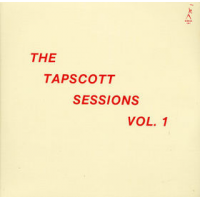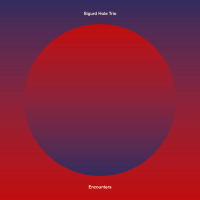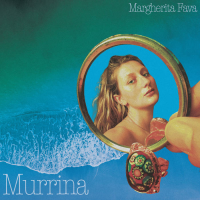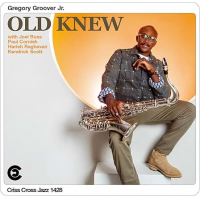Home » Jazz Articles » Multiple Reviews » Horace Tapscott: The Tapscott Sessions, Volumes 1-8
Horace Tapscott: The Tapscott Sessions, Volumes 1-8
 Tapscott was a unique pianist from an improvisational viewpoint. He used a melodic base as a foundation, but he was able to spring from that platform into music that was removed from the constraints of structure. He adeptly maintained a semblance of lyricism within a free verse stance to tie the threads together. This was most evident on compositions by him, and Volume 1 (June 1982) features three of his tunes that capture the essence of this concept. "Jenny's Spirit's Waltz," which opens the record, certainly has that captivating quality. It draws one into the melody line and then whisks one off in a semi-turbulent storm cloud while the refrain of the theme still lurks in the mind. His touch on the keys was not excessively percussive, yet he brought out thunderous resonance to disrupt the quietude before reverting to an intricate calming mode. With standards, such as the Howard Dietz-Arthur Schwartz gem "Alone Together," Tapscott infused this same dichotomic philosophy by honoring the theme while making the piece fully Tapscott-ian in improvisational development. The recording closes with a ten-minute search of the soul on "Haunted," where Tapscott does exactly that to one's mind set with his alternating refrain/exploration construction.
Tapscott was a unique pianist from an improvisational viewpoint. He used a melodic base as a foundation, but he was able to spring from that platform into music that was removed from the constraints of structure. He adeptly maintained a semblance of lyricism within a free verse stance to tie the threads together. This was most evident on compositions by him, and Volume 1 (June 1982) features three of his tunes that capture the essence of this concept. "Jenny's Spirit's Waltz," which opens the record, certainly has that captivating quality. It draws one into the melody line and then whisks one off in a semi-turbulent storm cloud while the refrain of the theme still lurks in the mind. His touch on the keys was not excessively percussive, yet he brought out thunderous resonance to disrupt the quietude before reverting to an intricate calming mode. With standards, such as the Howard Dietz-Arthur Schwartz gem "Alone Together," Tapscott infused this same dichotomic philosophy by honoring the theme while making the piece fully Tapscott-ian in improvisational development. The recording closes with a ten-minute search of the soul on "Haunted," where Tapscott does exactly that to one's mind set with his alternating refrain/exploration construction.  Volume 2 (November 1982) finds Tapscott in a reflective mood that chronicled a critical period in the expansion of civil rights in America. He makes a vivid statement on the 30-minute "Struggle X, An Afro-American Dream" recorded during a time when it was becoming evident that the ideals of leaders such as Martin Luther King would not be quickly realized. Tapscott builds the tune in stages starting with tranquil serenity cloaked by a disturbing sense of unrest. He adopts a non-violent posture while delving into the revelry of unfulfilled promises, and as the extended tune develops, it switches to disillusionment and near-anger. His piano becomes explosive as he hurls volatile statements seemingly in resentment to the dream gone astray. The tune resolves from darting and fleeting statements into a brooding textural summation where frustration seems to be the conclusion, yet he transforms that emotion ultimately into hope. Tapscott's developmental tactics on this piece are phenomenal. The recording closes on a quasi-romantic note with "Many Nights Ago," which contains the weight of a heavy heart hidden beneath a lighter, at times lilting, theme statement. This set clearly demonstrates Tapscott's ability to convey his innermost feelings to the listener.
Volume 2 (November 1982) finds Tapscott in a reflective mood that chronicled a critical period in the expansion of civil rights in America. He makes a vivid statement on the 30-minute "Struggle X, An Afro-American Dream" recorded during a time when it was becoming evident that the ideals of leaders such as Martin Luther King would not be quickly realized. Tapscott builds the tune in stages starting with tranquil serenity cloaked by a disturbing sense of unrest. He adopts a non-violent posture while delving into the revelry of unfulfilled promises, and as the extended tune develops, it switches to disillusionment and near-anger. His piano becomes explosive as he hurls volatile statements seemingly in resentment to the dream gone astray. The tune resolves from darting and fleeting statements into a brooding textural summation where frustration seems to be the conclusion, yet he transforms that emotion ultimately into hope. Tapscott's developmental tactics on this piece are phenomenal. The recording closes on a quasi-romantic note with "Many Nights Ago," which contains the weight of a heavy heart hidden beneath a lighter, at times lilting, theme statement. This set clearly demonstrates Tapscott's ability to convey his innermost feelings to the listener.  On Volume 3 (April 1983), Tapscott plays his compositions exclusively. He opens with the joyous "The Tuus," a breezy selection where he is able to scramble over the breadth of the keyboard spewing out reams of dancing notes; but just as quickly, he recedes into an introverted mood where reflective thought patterns dominate the landscape. This alternating pattern of lighthearted musings replaced with pensive deliberation appears regularly in the work of Tapscott. He conveys the image of a man torn between the good in the world and the known evil. Oddly, though, when he sinks into his "Reflections of Self," the scale is heavily tipped to the darker end of the spectrum. The intensity builds during the piece, but it remains mired in the deep recesses of his mind where lightness is not a factor. His concept of the blues on "Kopkee's Blues" is also tainted with dense shades more indicative of the racial origins of the musical form than the bouncy interpretations that succeeded it. He rises from the depression somewhat on the closing "After the Storm" to exude a glimmer of hope even though the song is devoid of gaiety. Mood swings are pervasive in his work, which is a quality that magnetically draws one to his music.
On Volume 3 (April 1983), Tapscott plays his compositions exclusively. He opens with the joyous "The Tuus," a breezy selection where he is able to scramble over the breadth of the keyboard spewing out reams of dancing notes; but just as quickly, he recedes into an introverted mood where reflective thought patterns dominate the landscape. This alternating pattern of lighthearted musings replaced with pensive deliberation appears regularly in the work of Tapscott. He conveys the image of a man torn between the good in the world and the known evil. Oddly, though, when he sinks into his "Reflections of Self," the scale is heavily tipped to the darker end of the spectrum. The intensity builds during the piece, but it remains mired in the deep recesses of his mind where lightness is not a factor. His concept of the blues on "Kopkee's Blues" is also tainted with dense shades more indicative of the racial origins of the musical form than the bouncy interpretations that succeeded it. He rises from the depression somewhat on the closing "After the Storm" to exude a glimmer of hope even though the song is devoid of gaiety. Mood swings are pervasive in his work, which is a quality that magnetically draws one to his music.  One of Tapscott's most delightful compositions opens Volume 4 (September 1982). His "A Dress for Reneé" has an infectious melody line to which he retreats regularly during the course of this sprightly interpretation. Tapscott was an outspoken critic of racial bigotry, and his music often reflected those sentiments. Yet on "Shades of Soweto," one hears the beauty of life in his playing and not the sadness the title could suggest. South African rhythms bounce around the tune but in a very subtle way. Tapscott was a demonstrative proponent of the left side of the keyboard, and nearly all of his pieces are heavily endowed with the thunderous bass line he generates from it. A surprise offering on this record is Tapscott's rendition of Arthur Blythe's "As of Yet." One can mentally hear Bob Stewart's tuba lines being recreated from Tapscott's left hand as he wrings the familiar melody out of his right. His adoption of the posture of a stride pianist is a recognizable trait, but he updates the historic format to make it new and fresh, as on "Whit" or "Forgiving." Volume 4 is filled with a mixture of perky melody lines and highly resonating rhythms, and while it is all soulful, the overt sadness seen elsewhere is not present.
One of Tapscott's most delightful compositions opens Volume 4 (September 1982). His "A Dress for Reneé" has an infectious melody line to which he retreats regularly during the course of this sprightly interpretation. Tapscott was an outspoken critic of racial bigotry, and his music often reflected those sentiments. Yet on "Shades of Soweto," one hears the beauty of life in his playing and not the sadness the title could suggest. South African rhythms bounce around the tune but in a very subtle way. Tapscott was a demonstrative proponent of the left side of the keyboard, and nearly all of his pieces are heavily endowed with the thunderous bass line he generates from it. A surprise offering on this record is Tapscott's rendition of Arthur Blythe's "As of Yet." One can mentally hear Bob Stewart's tuba lines being recreated from Tapscott's left hand as he wrings the familiar melody out of his right. His adoption of the posture of a stride pianist is a recognizable trait, but he updates the historic format to make it new and fresh, as on "Whit" or "Forgiving." Volume 4 is filled with a mixture of perky melody lines and highly resonating rhythms, and while it is all soulful, the overt sadness seen elsewhere is not present.  An experimental side of Tapscott emerges on Volume 5 (January 1984). He probes the inner components of his instrument by coaxing out eerie and mysterious tones from the piano strings on the appropriately titled "Stringeurisms." It is a rare chance to hear him in a fully liberated and freeform mode of expression where he allows the purity of the sound to take precedence over his intricate theme construction. This same expressiveness spills over to other songs on the recording, making it a more open and advanced set. Still, he does not abandon the rich melodic framework that characterizes his music, and those traits reappear on "Blues in Pirouette." In keeping with his determination to showcase Los Angeles Black composers, Tapscott tackles Samuel Browne's "Perfumes in the Night," and he portrays it in a nostalgic way with moody, pensive referrals to the lovely theme surrounded by his intricate diversionary tactics. The sad blues undercurrent returns on the highly resonant "Hy-Pockets' Swan Song," where the cascading left hand tonality of the Steinway competes aggressively with the theme-drenched right. Tapscott appears heavy of heart on this date, but then again, that trait often drove his best performances.
An experimental side of Tapscott emerges on Volume 5 (January 1984). He probes the inner components of his instrument by coaxing out eerie and mysterious tones from the piano strings on the appropriately titled "Stringeurisms." It is a rare chance to hear him in a fully liberated and freeform mode of expression where he allows the purity of the sound to take precedence over his intricate theme construction. This same expressiveness spills over to other songs on the recording, making it a more open and advanced set. Still, he does not abandon the rich melodic framework that characterizes his music, and those traits reappear on "Blues in Pirouette." In keeping with his determination to showcase Los Angeles Black composers, Tapscott tackles Samuel Browne's "Perfumes in the Night," and he portrays it in a nostalgic way with moody, pensive referrals to the lovely theme surrounded by his intricate diversionary tactics. The sad blues undercurrent returns on the highly resonant "Hy-Pockets' Swan Song," where the cascading left hand tonality of the Steinway competes aggressively with the theme-drenched right. Tapscott appears heavy of heart on this date, but then again, that trait often drove his best performances.  An Oriental theme permeates "Ancestral Echoes," the opener of Volume 6 (October 1993). With extensive probing, Tapscott moves to a mixture of European and Asian influences as he sinks into a pondering mood. The tune also honors the Native American in its rhythm line, suggesting Tapscott is respecting multiple cultures with this one statement. His freeform movements are brief but dovetail beautifully into the rich textures of the song replete with dominant left hand emphasis. The works of three Los Angeles area Black composers are on the play list, further reinforcing his identification with his adopted city and his determination to promote racial equality. Tapscott stirs in a touch of the blues on Reuben King's "Restless Nights," paints a vivid picture of Roy Porter's "Jessica," and projects a visionary sense on Kaeef Ruzadun's "New Horizon." This volume has a melancholy thread weaving through it, again demonstrating how adeptly Tapscott could convey a very personal mood. He often showed a darker side of his personality through his playing, but invariably, the songs conclude with a ray of sunshine rather than resolving into despair.
An Oriental theme permeates "Ancestral Echoes," the opener of Volume 6 (October 1993). With extensive probing, Tapscott moves to a mixture of European and Asian influences as he sinks into a pondering mood. The tune also honors the Native American in its rhythm line, suggesting Tapscott is respecting multiple cultures with this one statement. His freeform movements are brief but dovetail beautifully into the rich textures of the song replete with dominant left hand emphasis. The works of three Los Angeles area Black composers are on the play list, further reinforcing his identification with his adopted city and his determination to promote racial equality. Tapscott stirs in a touch of the blues on Reuben King's "Restless Nights," paints a vivid picture of Roy Porter's "Jessica," and projects a visionary sense on Kaeef Ruzadun's "New Horizon." This volume has a melancholy thread weaving through it, again demonstrating how adeptly Tapscott could convey a very personal mood. He often showed a darker side of his personality through his playing, but invariably, the songs conclude with a ray of sunshine rather than resolving into despair.  Tapscott goes on a furious run on "Riding the San Andreas," on Volume 7 (February 1983). He builds swirling commotion by manipulating the piano strings with his right hand while the left hand turns out of character and provides the eruptive melody line. The tune has cyclonic force as a driver, but eventually the winds taper off and one hears again the expectation of peace in his music. Tapscott's unique way of bringing the stride piano into the modern era is again shown on "Southwestern Avenue Shuffle," a lark of a tune built on a happy beat. In an unexpected move, Tapscott takes on Monk's "'Round Midnight." Even though the tune has had vast exposure through the years, Tapscott is able to personalize the classic. His scampering on the bridge is refreshing and borders on the freeform side for a brief segment before gliding into a waltz tempo. At one point, Tapscott pays tribute to the great man by replicating his quick, single-note high register signature card. Charles Tolliver's "On the Nile" is also included on this set, challenging Tapscott to convey in musical terms the majesty of the world's longest river. He succeeds with aplomb. Tapscott closes with his "Sonnet of Butterfly McQueen," where one hears an uncharacteristic predominance of high-end skirmishes even though he does not fully forsake the influential bottom end.
Tapscott goes on a furious run on "Riding the San Andreas," on Volume 7 (February 1983). He builds swirling commotion by manipulating the piano strings with his right hand while the left hand turns out of character and provides the eruptive melody line. The tune has cyclonic force as a driver, but eventually the winds taper off and one hears again the expectation of peace in his music. Tapscott's unique way of bringing the stride piano into the modern era is again shown on "Southwestern Avenue Shuffle," a lark of a tune built on a happy beat. In an unexpected move, Tapscott takes on Monk's "'Round Midnight." Even though the tune has had vast exposure through the years, Tapscott is able to personalize the classic. His scampering on the bridge is refreshing and borders on the freeform side for a brief segment before gliding into a waltz tempo. At one point, Tapscott pays tribute to the great man by replicating his quick, single-note high register signature card. Charles Tolliver's "On the Nile" is also included on this set, challenging Tapscott to convey in musical terms the majesty of the world's longest river. He succeeds with aplomb. Tapscott closes with his "Sonnet of Butterfly McQueen," where one hears an uncharacteristic predominance of high-end skirmishes even though he does not fully forsake the influential bottom end.  Volume 8 (1984) is taken from several sessions during that year, and it is the first of the series to be released as a CD. Tapscott deviated in policy by playing only one of his compositions, but he filled the program with gems by Mal Waldron, Randy Weston, and Thelonious Monk. It is truly amazing how Tapscott could reshape these composer-dominated tunes into his own vocabulary and image. The dancing melody of Waldron's "Fire Waltz" breathes new life under Tapscott's hand. He regularly alters the tempo, adds his personal signature, and scurries off on a 15-minute jaunt of complex improvisations while always filtering in traces of the melody. Weston's "Little Niles" is a great vehicle for Tapscott. The North African mystique reoccurs frequently during the presentation, but the tune also allows him to be expansive with his improvising. As occurs on Volume 7, Tapscott's approach to Monk is fully original. Once the melody line of "Crepuscule with Nellie" is stated, Tapscott reconfigures the tune with slow, methodical precision and an open stance. He closes with one of his most beautiful songs. "As a Child" is all Tapscott in content, structure, and development, and its melody is infectious. It embodies all that is Tapscott.
Volume 8 (1984) is taken from several sessions during that year, and it is the first of the series to be released as a CD. Tapscott deviated in policy by playing only one of his compositions, but he filled the program with gems by Mal Waldron, Randy Weston, and Thelonious Monk. It is truly amazing how Tapscott could reshape these composer-dominated tunes into his own vocabulary and image. The dancing melody of Waldron's "Fire Waltz" breathes new life under Tapscott's hand. He regularly alters the tempo, adds his personal signature, and scurries off on a 15-minute jaunt of complex improvisations while always filtering in traces of the melody. Weston's "Little Niles" is a great vehicle for Tapscott. The North African mystique reoccurs frequently during the presentation, but the tune also allows him to be expansive with his improvising. As occurs on Volume 7, Tapscott's approach to Monk is fully original. Once the melody line of "Crepuscule with Nellie" is stated, Tapscott reconfigures the tune with slow, methodical precision and an open stance. He closes with one of his most beautiful songs. "As a Child" is all Tapscott in content, structure, and development, and its melody is infectious. It embodies all that is Tapscott. Tapscott was a prolific composer of memorable music and an astute interpreter of the compositions of others. His Tapscott Sessions series offered him a rare chance to expose to the world the beauty inherent in his work. More importantly, the series permits the listener to peek into the man's soul. Everything Tapscott played was played with emotion, sensitivity, and deep feeling. He seems to have worn his heart on his sleeve, and every time he touched the keys, significant music blossomed. Tapscott was a rare individualist who was committed to his beliefs. Through his playing, he was able to tell the world how he felt, and the world is a better place for having heard what he said. I had the wonderful opportunity of experiencing his magic live in Houston in 1992, and it was a memorable event. A second opportunity failed to materialize in 1998 when he was forced to cancel his Guelph Festival appearance due to illness. Tapscott died six months later on March 14, 1999. Through his music he tried to change the world, but bigotry is a difficult demon to stamp out. Tapscott's music hauntingly lingers in the recesses of the mind long after the performance has ended, and one is hard pressed to spin fully clear of it or what the man represented.
See Discogs.com for track listing.
Tags
PREVIOUS / NEXT
Support All About Jazz
 All About Jazz has been a pillar of jazz since 1995, championing it as an art form and, more importantly, supporting the musicians who make it. Our enduring commitment has made "AAJ" one of the most culturally important websites of its kind, read by hundreds of thousands of fans, musicians and industry figures every month.
All About Jazz has been a pillar of jazz since 1995, championing it as an art form and, more importantly, supporting the musicians who make it. Our enduring commitment has made "AAJ" one of the most culturally important websites of its kind, read by hundreds of thousands of fans, musicians and industry figures every month.





















